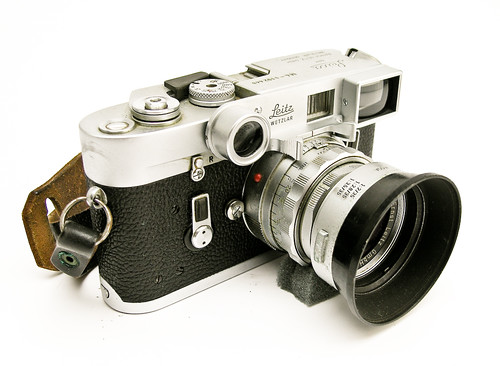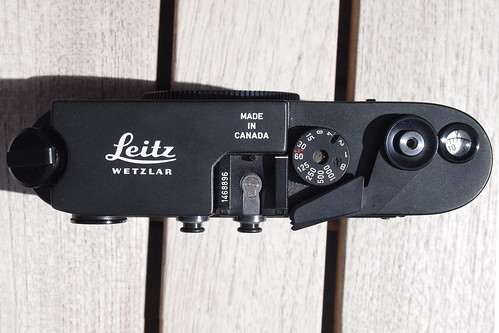Difference between revisions of "Leica M4"
m (aligned image to the right so it's inline with text) |
(Revise and merge articles) |
||
| Line 8: | Line 8: | ||
}} | }} | ||
| − | The '''Leica M4''' was introduced in 1967, and replaced the 1954 [[Leica M3]]. The Leica M4 is by many photographers and collectors alike | + | The '''Leica M4''' was introduced in 1967, and replaced the 1954 [[Leica M3]]. The Leica M4 is considered by many photographers and collectors alike as the definitive model of the Leica rangefinder cameras. |
| + | |||
| + | The M4 is an all mechanical manual exposure camera without a built in exposure meter. A clip on coupled exposure meter was available as an accessory. Also available was the 'Visoflex' reflex head, which turned the camera into an [[SLR]]. Visoflex lenses have a different mount and cannot be used except wht the Visoflex. | ||
| + | |||
| + | ==Leica M4-2== | ||
| + | {|class=floatright | ||
| + | | | ||
| + | {{Flickr_image | ||
| + | |image_source= http://www.flickr.com/photos/pekdeche/5005750413/in/pool-camerawiki | ||
| + | |image= http://farm5.static.flickr.com/4091/5005750413_920b0b2484.jpg | ||
| + | |image_align= | ||
| + | |image_text= | ||
| + | |image_by= Pekdeche | ||
| + | |image_rights= wp | ||
| + | }} | ||
| + | |- | ||
| + | | | ||
| + | {{Flickr_image | ||
| + | |image_source= http://www.flickr.com/photos/pekdeche/5005749333/in/pool-camerawiki | ||
| + | |image= http://farm5.static.flickr.com/4074/5005749333_130860caaf.jpg | ||
| + | |image_align= | ||
| + | |image_text= | ||
| + | |image_by= Pekdeche | ||
| + | |image_rights= wp | ||
| + | }} | ||
| + | |} | ||
| + | Following the disastrous [[Leica M5|M5]], the M4 was reintroduced in 1978 as the M4-2 manufactured in Canada, with only detail differences. | ||
| + | |||
| + | |||
| + | ==Links== | ||
| + | *[http://www.collection-appareils.fr/x/html/page_standard.php?id_appareil=11436 Leica M4-2] at [http://www.collection-appareils.fr/general/html/francais.php Sylvain Halgand's www.collection-appareils.fr] | ||
| + | *[http://www.cameraquest.com/mguide.htm#M4-2%20and%20M4-P Leica M-series guide] at Stephen Gandy's [http://www.cameraquest.com/classics.htm CameraQuest] | ||
| + | |||
| + | [[Category:German 35mm rangefinder]] | ||
| + | [[Category:Leica]] | ||
| + | |||
| + | <!-- Irrelevant content commented out | ||
| + | The reason is the finder optics and the superior mechanical quality, not convincingly equalled in later models. However, the question of which is best, boils down to preferences with regards to the finder magnification and which finder frames are needed. Otherwise, there is actually not very much difference among the classic Leica M's, other than the early Leica M3 with double stroke wind lever, the rangefinder-less M1, and the slanted Leica M4 rewind knob. | ||
The Leica has a particular shutter sound that connoisseurs appreciate, and there is the highly appreciated feel of quality in every detail. Never the less, the modern Leicas are far removed from the original handmade screw lensmount cameras built of an aluminium tube, steel spindles, and brass plates screwed together. The M-body is a metal casting machined to close tolerances, and every component made to perform reliably under strenuous conditions. The four-pronged lensmount is quick and reliable, and the relevant parallax compensated field-of-view frame is automatically shown in the finder. The standard lens for the M4 would be any number of top quality Leica Lenses. | The Leica has a particular shutter sound that connoisseurs appreciate, and there is the highly appreciated feel of quality in every detail. Never the less, the modern Leicas are far removed from the original handmade screw lensmount cameras built of an aluminium tube, steel spindles, and brass plates screwed together. The M-body is a metal casting machined to close tolerances, and every component made to perform reliably under strenuous conditions. The four-pronged lensmount is quick and reliable, and the relevant parallax compensated field-of-view frame is automatically shown in the finder. The standard lens for the M4 would be any number of top quality Leica Lenses. | ||
| Line 23: | Line 60: | ||
In addition, there have been several shorter runs of models, like the MP professional and the MD with no finder. Se [[Leica M chronology]] list. | In addition, there have been several shorter runs of models, like the MP professional and the MD with no finder. Se [[Leica M chronology]] list. | ||
[[Category:Leica]] | [[Category:Leica]] | ||
| + | --> | ||
Revision as of 17:28, 7 January 2013

|
| Photo of Leica M4 with Summicron-M 50mm/2 Dual Range equipped for close-up use. image by Christopher Robin Roberts |
The Leica M4 was introduced in 1967, and replaced the 1954 Leica M3. The Leica M4 is considered by many photographers and collectors alike as the definitive model of the Leica rangefinder cameras.
The M4 is an all mechanical manual exposure camera without a built in exposure meter. A clip on coupled exposure meter was available as an accessory. Also available was the 'Visoflex' reflex head, which turned the camera into an SLR. Visoflex lenses have a different mount and cannot be used except wht the Visoflex.
Leica M4-2
| ||
|
Following the disastrous M5, the M4 was reintroduced in 1978 as the M4-2 manufactured in Canada, with only detail differences.
Links
- Leica M4-2 at Sylvain Halgand's www.collection-appareils.fr
- Leica M-series guide at Stephen Gandy's CameraQuest

